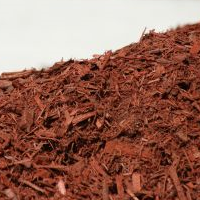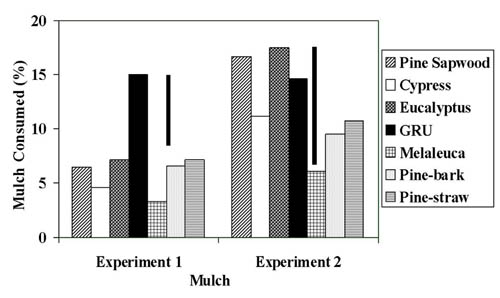 Spreading mulch in and around your landscaping has several benefits including: helping to keep weed growth to a minimum, moderating soil temperature by keeping out sunlight and maintaining moisture from rainfall/watering in the soil by preventing sunlight from drying it out and slowing evaporation.
Spreading mulch in and around your landscaping has several benefits including: helping to keep weed growth to a minimum, moderating soil temperature by keeping out sunlight and maintaining moisture from rainfall/watering in the soil by preventing sunlight from drying it out and slowing evaporation.
Thickness: We’ve all probably heard different stories about how thick to spread mulch, anywhere from 2-3 inches all the way up to 5-6 inches. While the difference in thickness varies in opinion, a common practice that seems to work well is 3-4″ in open areas and 2-3″ around the base of trees and shrubs.
There are different types of mulch available such as: cypress, red-dyed, pine bark nuggets (chips), melaleuca and even eucalyptus mulch. Some people also use rubber or stone in place of mulch.
Cypress mulch was very popular over the years (especially during the housing boom) and still is to some extent but keep in mind that Florida cypress trees were being cut down at a faster rate then they were being replaced with new growth for many years.
Pine bark is much more eco-friendly because the pine bark chips are from leftover by-products of the lumber industry. Eucalyptus mulch is from tress grown specifically for mulching and melaleuca is:
Melaleuca is an invasive exotic that is taking over wetlands by inhibiting the growth of native plants. It makes a very good mulch and it is the most resistant of all the organic mulches from termites. Increased demand from homeowners and commercial locations for melaleuca mulch has increased the removal of melaleuca from our wetlands.1
If you live in a wood-framed house, care must be taken when using mulch because Florida resident Termites love mulch. The University of Florida IFAS Extension (Institute of Food & Agricultural Sciences) has performed testing to see which type of mulch subterranean termites like and don’t like:
Figure 2. Termite consumption of six landscape mulches showing that termites ate all mulches but liked melaleuca the least. (Bars show significant differences.)
See U.F. IFAS Extension testing and results explained in further detail here:
Landscape Mulches: Will Subterranean Termites Consume Them?
Note that GRU in the above results refers to Gainesville Regional Utility (GRU) mulch which was taken from local utility prunings (leaves, bark and branches) which contained a mixture of: oaks, cherry, cedar, camphor and southern pine. This would be similar to what you’ll find in sometimes free mulch after a hurricane in Florida as mentioned below:
After a hurricane there is always a plentiful supply of free mulch from all of the fallen trees that have been chipped up (and sometimes the mulched trees are sold). While free mulch is great, many people found out that there were other things mixed in with the mulch and they wound up with a whole bunch of weeds over time, much more than usual. Putting down some kind of weed block prior to the mulch could help slow down the speed at which the weeds will show up. In addition, not knowing what types of wood are in the mulch can be asking for trouble by potentially attracting unwanted termites.
As a homeowner, keeping up with a termite inspection and prevention program should be high on the list of things to do for protecting your home.
Here’s another test result chart below from the U.F. IFAS Extension1 with different types of cypress and melaleuca separated which is important because the majority of cypress mulch available is cypress sapwood, which as you can see below is not very termite friendly at all.



 Thank you for stopping by our website. In addition to providing quality lawn care, customer satisfaction and great communication are some of my top priorities. If you would like to request a price quote, please send us a message using our contact form and we will follow up as soon as possible.
Thank you for stopping by our website. In addition to providing quality lawn care, customer satisfaction and great communication are some of my top priorities. If you would like to request a price quote, please send us a message using our contact form and we will follow up as soon as possible.